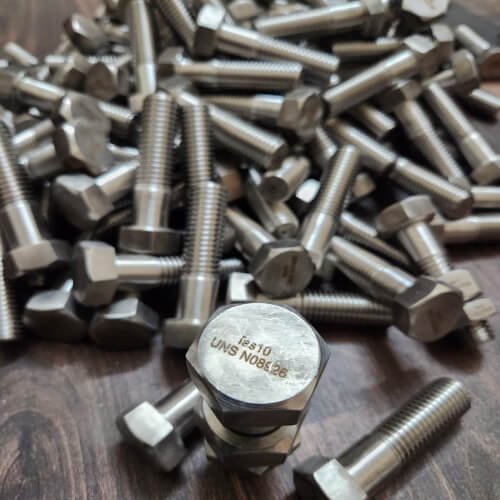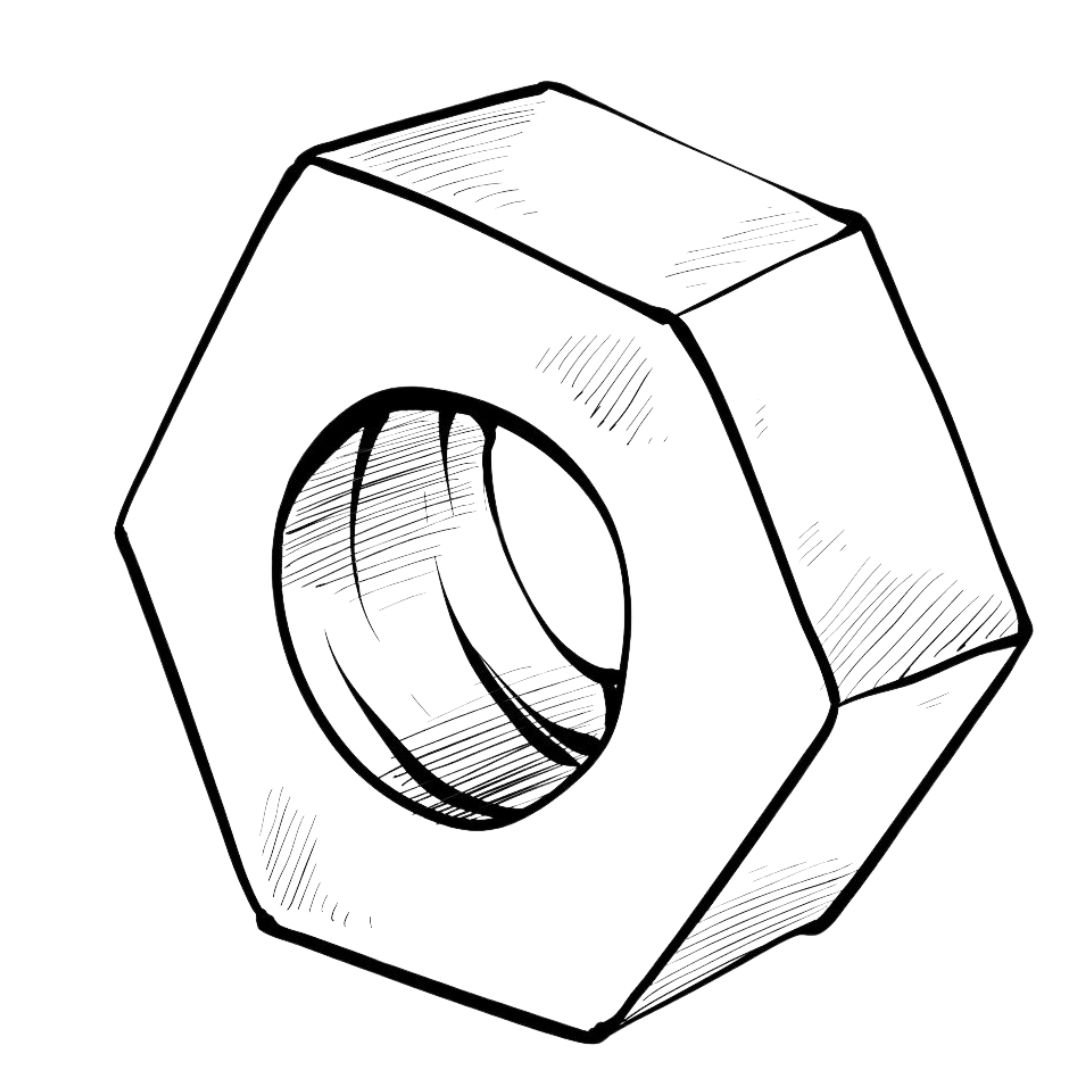Fastener Weight Calculator
- Fastener Weight Calculator
-
Tolerance Calculator
- Hardness Conversion Calculator

To calculate the weight of a fastener, you will need to know the dimensions of the fastener and the material it is made of. Here is a general formula you can use to calculate the weight:
Weight = Volume x Density
Where:
- Volume = π/4 x d² x l (for cylindrical fasteners)
- d = diameter of the fastener
- l = length of the fastener
- π = 3.14 (pi)
- Density = mass/volume (density of the material the fastener is made of)
So, to calculate the weight of a cylindrical fastener made of a certain material, you would need to:
- Measure the diameter (d) and length (l) of the fastener.
- Calculate the volume (V) of the fastener using the formula above.
- Look up the density of the material the fastener is made of.
- Multiply the volume (V) by the density to get the weight of the fastener.
Here is an example:
Suppose you have a cylindrical fastener with a diameter of 10mm and a length of 50mm, made of stainless steel (density of 7.9 g/cm³). Using the formula above:
Volume = π/4 x d² x l = 3.14/4 x 10² x 50 = 3927.0 mm³ Density = 7.9 g/cm³ = 0.0079 g/mm³ Weight = Volume x Density = 3927.0 x 0.0079 = 31.0 g
Therefore, the weight of the stainless steel fastener is 31.0 grams.
Tolerances for shafts and holes
Find and calculate tolerances for holes and shafts.
Based on standard tolerance classes and limit deviations from ISO 286-2:2010
Reference Table: Steel hardness conversion chart - all values approximate. |
||||
| Brinell Hardness HB | Rockwell HRC | Rockwell HRB | Vickers HV | N/mm² |
| 800 | 72 | |||
| 780 | 71 | |||
| 760 | 70 | |||
| 752 | 69 | |||
| 745 | 68 | |||
| 746 | 67 | |||
| 735 | 66 | |||
| 711 | 65 | |||
| 695 | 64 | |||
| 681 | 63 | |||
| 658 | 62 | |||
| 642 | 61 | |||
| 627 | 60 | |||
| 613 | 59 | |||
| 601 | 58 | 746 | ||
| 592 | 57 | 727 | ||
| 572 | 56 | 694 | ||
| 552 | 55 | 649 | ||
| 534 | 54 | 120 | 589 | |
| 513 | 53 | 119 | 567 | |
| 504 | 52 | 118 | 549 | |
| 486 | 51 | 118 | 531 | |
| 469 | 50 | 117 | 505 | |
| 468 | 49 | 117 | 497 | |
| 456 | 48 | 116 | 490 | 1569 |
| 445 | 47 | 115 | 474 | 1520 |
| 430 | 46 | 115 | 458 | 1471 |
| 419 | 45 | 114 | 448 | 1447 |
| 415 | 44 | 114 | 438 | 1422 |
| 402 | 43 | 114 | 424 | 1390 |
| 388 | 42 | 113 | 406 | 1363 |
| 375 | 41 | 112 | 393 | 1314 |
| 373 | 40 | 111 | 388 | 1265 |
| 360 | 39 | 111 | 376 | 1236 |
| 348 | 38 | 110 | 361 | 1187 |
| 341 | 37 | 109 | 351 | 1157 |
| 331 | 36 | 109 | 342 | 1118 |
| 322 | 35 | 108 | 332 | 1089 |
| 314 | 34 | 108 | 320 | 1049 |
| 308 | 33 | 107 | 311 | 1035 |
| 300 | 32 | 107 | 303 | 1020 |
| 290 | 31 | 106 | 292 | 990 |
| 277 | 30 | 105 | 285 | 971 |
| 271 | 29 | 104 | 277 | 941 |
| 264 | 28 | 103 | 271 | 892 |
| 262 | 27 | 103 | 262 | 880 |
| 255 | 26 | 102 | 258 | 870 |
| 250 | 25 | 101 | 255 | 853 |
| 245 | 24 | 100 | 252 | 838 |
| 240 | 23 | 100 | 247 | 824 |
| 233 | 22 | 99 | 241 | 794 |
| 229 | 21 | 98 | 235 | 775 |
| 223 | 20 | 97 | 227 | 755 |
| 216 | 19 | 96 | 222 | 716 |
| 212 | 18 | 95 | 218 | 706 |
| 208 | 17 | 95 | 210 | 696 |
| 203 | 16 | 94 | 201 | 680 |
| 199 | 15 | 93 | 199 | 667 |
| 191 | 14 | 92 | 197 | 657 |
| 190 | 13 | 92 | 186 | 648 |
| 186 | 12 | 91 | 184 | 637 |
| 183 | 11 | 90 | 183 | 617 |
| 180 | 10 | 89 | 180 | 608 |
| 175 | 9 | 88 | 178 | 685 |
| 170 | 7 | 87 | 175 | 559 |
| 167 | 6 | 86 | 172 | 555 |
| 166 | 5 | 86 | 168 | 549 |
| 163 | 4 | 85 | 162 | 539 |
| 160 | 3 | 84 | 160 | 535 |
| 156 | 2 | 83 | 158 | 530 |
| 154 | 1 | 82 | 152 | 515 |
| 149 | 81 | 149 | 500 | |
| 147 | 80 | 147 | 490 | |
| 143 | 79 | 146 | 482 | |
| 141 | 78 | 144 | 481 | |
| 139 | 77 | 142 | 480 | |
| 137 | 76 | 140 | 475 | |
| 135 | 75 | 137 | 467 | |
| 131 | 74 | 134 | 461 | |
| 127 | 72 | 129 | 451 | |
| 121 | 70 | 127 | 431 | |
| 116 | 68 | 124 | 422 | |
| 114 | 67 | 121 | 412 | |
| 111 | 66 | 118 | 402 | |
| 107 | 64 | 115 | 382 | |
| 105 | 62 | 112 | 378 | |
| 103 | 61 | 108 | 373 | |
| 95 | 56 | 104 | ||
| 90 | 52 | 95 | ||
| 81 | 41 | 85 | ||
| 76 | 37 | 80 | ||
| Brinell HB | Rockwell HRC | Rockwell HRB | Vickers HV | N/mm² |
| 3000kg 10mm Ball | 150kg Brale | 100kg 1/16" Ball | Diamond Pyramid | Tensile strength (Approx) |
Reference table: Steel Hardness conversion chart Since the various types of hardness tests do not all measure the same combination of material properties, conversion from one hardness scale to another is only an approximate process. Because of the wide range of variation among different materials, it is not possible to state confidence limits for the errors in using a conversion chart. |
||||





